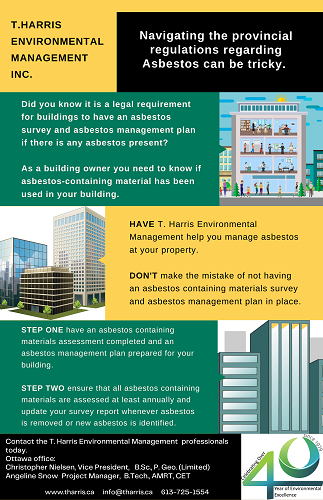 Saturday, April 20, 2024
Saturday, April 20, 2024  Saturday, April 20, 2024
Saturday, April 20, 2024 
by Christopher Nielsen, B.Sc., P. Geo. (Limited), Vice President T. Harris Environmental Management Inc.
Maintainers making repairs or anyone else working in a facility may encounter asbestos. It wraps around pipes and elbows, it lines boilers and it’s present in a host of ordinary construction materials, including wallboard and ceiling tiles.
Asbestos is often safely contained and the threat to average workers is minimal. Maintenance and repair work, however, can involve making changes to systems with asbestos fibres being released into the air (i.e. sawing pipes wrapped in asbestos; and cutting holes in walls, floors and ceilings that were built with asbestos-containing materials).
The right approach to asbestos safety involves understanding the hazards and knowing how to protect yourself and fellow workers. Crucial elements are awareness and the provision of effective training.
Asbestos isn’t a single material, but rather a group of fibrous silicates that has been mined commercially for years. Following the mining process, these materials were refined and added to literally thousands of different construction materials.
With growing understanding of the health risks of asbestos, usage plummeted in the 1970s and 1980s to a very limited current application in Canada. Those working in building construction before 1985, however, face the unpleasant results of previous builders’ enthusiastic use of asbestos.
Asbestos is now associated with a wide range of diseases, which are usually fatal and typically incurable. Many of them have long latency periods, so the full effects are only now appearing. It’s estimated that in the US, 12,000 to 15,000 people die each year from asbestos-related diseases. A quarter of these are related to mesothelioma, which is one form of incurable asbestos-induced cancer.
Eighty-four percent of all occupational disease fatalities in Ontario between 1995 and 2004 were asbestos related. Experts fear the number of asbestos related diseases will rise significantly in the next decade before they start to fall. This is due to the implementation of regulations to control asbestos, which didn’t come into effect until the late 1970s or early 1980s, and latency periods associated with these diseases.
Better understanding of the threat posed by asbestos means that provinces have put in place new regulations on asbestos handling, which have big implications for property owners. Most of these regulations, such as Ontario Regulation 278/05, change the definition of “asbestos-containing material” and raise the requirements on how it must be handled.
Most provinces have expanded the range of products that must now be considered suspect asbestos containing. In many cases, the percentage of asbestos in material, which triggers the need for special handling, is lower.
Building renovations may find the work slowed or stopped by inspectors, union leaders and employees who discover suspect asbestos-containing materials that haven’t been identified in assessments. Supervisors, management, and company owners/directors are obligated to provide a safe working environment.
It’s also important to note that asbestos still finds its way into some building materials being used today, including asbestos-cement drainpipes, gaskets, and potentially other non-friable materials. While these materials may have some short-term cost benefits, they may have legal repercussions.
For example, in some jurisdictions once asbestos-containing materials are installed, their presence, along with the presence of any other known asbestos-containing material – must be noted in a record. The next step is to make the record available to workers at the site, especially if they may come into contact with asbestos.
Additionally, once the presence of asbestos-containing materials is known, regular inspections must be carried out, at least annually, to determine that the asbestos doesn’t pose a health hazard to building occupants. These requirements may make it worthwhile for anyone involved in new construction or renovation projects to ensure their new building materials remain asbestos-free.
To increase awareness, effective asbestos training will discuss the different materials that may contain asbestos, as well how to recognize these materials and control the asbestos hazards. Related training also should provide an understanding of when it’s appropriate to call in expert consultants and asbestos-remediation specialists.
Many supervisors and workers are unaware that cutting asbestos with power tools creates a much greater hazard than using hand tools. The need for PPW means that there’s also a need to provide training in its correct use, so that workers can be protected. Worksite preparation also is important, including the wetting down of the work area.
If the risk isn’t properly managed (asbestos fibres released through construction work) may diffuse into other parts of the building through the HVAC system.
You must keep training alive through refresher courses and a program that involves proper training of the new employees. There also are regulatory requirements to implement asbestos-management programs (AMP) or operations and maintenance programs, which stipulate how asbestos should be handled.
Being able to show employees and other users of the building that their health is being safeguarded is an important aspect of asbestos management.
Christopher Nielsen, B.Sc., P. Geo. (Limited), Vice President T. Harris Environmental Management Inc. Christopher has over 30 plus years in the environmental management sector.